| WAT PHRA RAM (วัดพระราม) |
| Wat Phra Ram is a restored ruin located in the Historical Park of Ayutthaya in Pratu Chai Sub-district and situated close to the Grand Palace and Wat Phra Sri Sanphet in a swampy area called Bueng Phra Ram. The monastery was constructed on the cremation site of the first Ayutthayan monarch, King Ramathibodi I (r. 1351-1369). History The exact time of its construction is not known as the various Chronicles of Ayutthaya give different timings of its construction. The oldest version, the Luang Prasoet, written during the Late Ayutthayan era, states its establishment in 1369 [1]. Later versions written in the post-Ayutthayan era put its construction in the year 1434, after the death of Borommaracha II (r. 1424-1448) and the throne ascending of King Borommatrailokanat (r. Ayutthaya 1448-1463 / r. Phitsanulok 1463 -1488), somehow 65 year later. "And on the cremation site for King Ramathibodi I, he who had founded the Capital, the King had a holy monastery established, consisting of a great holy reliquary and a holy preaching hall, and he named it the Phra Ram Monastery." [2] The Luang Prasoet version tells us that Wat Phra Ram was the first constructed temple at the time King Ramathibodi I passed away. The later versions could also be interpreted as that the monastery was expanded with a Khmer-styled prang and a vihara. Nobody knows exactly. The general time line of its construction followed by most scholars is that King Ramesuan (r.1369-1370 / 1st reign) ordered the construction of Wat Phra Ram in 1369 at his father’s cremation site. King Ramesuan abdicated after a year while the construction was not yet completed. His successor King Borommaracha I (r.1370-1388) probably carried on Wat Phra Ram’s construction work. Another assumption is that King Ramesuan resumed the work after his return to the throne (r.1388-1395 / 2nd reign). A major renovation of is presumed to have been undertaken in the reign of King Borommatrailokanat. Another major restoration took place in 1741 in the Late Ayutthaya period during Borommakot’s reign (r. 1733-1758). [3] The acquisition of merit But why such temples? Robert Heine-Geldern explains in his "Conceptions of State and Kingship in Southeast Asia" (1956) that the religious merit acquired in previous lives, makes a man born a king or makes him acquire kingship during his lifetime. Merit was as thus political legitimacy. The more merit was accrued (in building temples and offering valuables), the more legitimacy for the king or the king-to-be was endowed. The whole kingship is about the possession of great religious merit. Central to Buddhism, but especially to Theravada is the acquisition of "Bun" (lit: merit). The concept of merit was based on the law of karma (Th: kam) and was in fact the basis for the Theravada Kingship. Constructing a temple was regarded as highly meritorious and the deed that brought most merit. By donating the site to the monkhood, the king could acquire merit at the same time as he showed his reverence for his predecessor or royal ancestor, commemorated in the temple. To deposit the remains of a former king inside a prang or chedi would also ensure his eventual rebirth as a Buddha. [4] The same concept of merit was applicable to valuables deposed in crypts. It has long been a funeral custom to deposit valuable and cherished belongings of the deceased together with the ashes of the dead. Relatives made votive offerings specially fabricated for the occasion in the gesture of making merit (hence the many votive tablets found in the different crypts). For example most of the treasures found in the crypt of Wat Racha Burana were the possessions of the two princes (even clothes, the latter although perished instantly when dug up and came in contact with the atmosphere). Some part of them might been inherited by them from their ancestors. A large number of votive objects came probably from the third brother, King Borommaracha II. Also close followers donated their treasures to the deceased as a token of their homage and in a gesture of merit making. [5] In the Early Ayutthaya period it seemed to be a custom to establish a monastery on the Royal funeral pyre and to erect a funeral monument (chedi/prang) for the deceased in commemoration. Examples for this period were next to Wat Phra Ram (funeral pyre of King Ramathibodi I), Wat Racha Burana - funeral pyre of the princes Phraya Ay & Yi and King Intharacha (r.1409-1424). This continued in the Middle Ayutthaya period, for example: Wat Sop Sawan - Funeral pyre of Queen Suriyothai and daughter - Memorial Chedi at Wat Suan Luang. Another practice throughout the Ayutthayan era was to build a monastery on the site of a former royal residence, examples were: Wat Phutthaisawan - Palace site of U-Thong prior establishing Ayutthaya; Wat Sri Sanphet - Old Grand Palace location and Wat Chai Wathanaram - Residence of Prasat Thong's foster mother (although here were also other motives). Architecture Wat Wat Phra Ram as Wat Maha That, Wat Phutthaisawan and the later built Wat Racha Burana follows the Khmer concept of temple construction. We find nearly identical, but earlier built structures at Angkor. Phnom Bakheng, Preah Rup, East Mebon, Baphuon and Ta Keo were all Temple Mountains, consisting of a central tower surrounded by four corner towers, forming a quincunx, the latter also often was surrounded by a courtyard and a gallery. I will not repeat the architectural features of this type of temple, as it has been already elaborated on the web page of the other three above mentioned temples. Here I would like to let history speak, in the description of Wat Phra Ram written by the French Jesuit Guy Tachard during his stay in Ayutthaya in 1685. "About an hundred paces South of the Palace Area there is a great Park (1) walled in, in the middle where of stands a vast and high Fabric built cross-ways in the manner of our Churches, having over it five solid gilt domes of Stone or Brick, and of extraordinary Architecture, the dome in the middle is far bigger than the rest, which are on the extremities and at the ends of the Cross. This building rests upon several bases or pedestals, which are raised one over another, tapering and growing narrower towards the top. The way up to it on the four sides is only by narrow and steep stairs of betwixt thirty and forty steps threehands broad apiece and all covered with gilt Calin (2) or Tin like the Roof. The bottom of the great Stair-cafe is adorned on both sides with above twenty Statues bigger than the Life, some where-of are of Brass, and the rest of Calin and all gilt, but representing but sorrily the Persons and Animals for whom they have been made. This great Pile of Building is encompassed with forty four great Piramides of different form and well wrought ranked orderly upon different Platforms. On the lower platform stand the four greatest at the four corners of it upon large bases. These Piramides end at the top in a long very slender Cone, extreamly well gilt, and, supporting a Needle or Arrow of Iron, that pierces through, several Christal balls of an unequal bigness. The body of those great Piramides as well as of the rest, is of a kind of Architecture that comes pretty near ours; but it has too much Sculpture upon it, and wanting both the simplicity and proportions of ours it comes short of its beauty, at least in the eyes of those that are not accustomed to it..." [6] Read the complete text from Guy Tachard on Wat Phra Ram here. Maps Johannes Vingboons (c.1616 - 1670) was a Dutch cartographer and water colourist, who published his first drawings of Ayutthaya around 1665. The overall ground plan of Ayutthaya is wrong and its shape is distorted, certainly in the north-western part. The authors of "Van Vliet’s Siam"[6] though, situate Wat Phra Ram on the Vingboons'map, as "a large central chedi flanked by two smaller ones, and a wihan beside them". |

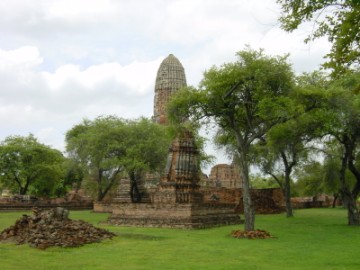
| "In 731, a year of the cock, Phra Ram Monastery was first constructed." [1] |
| On the most accurate map of the French Engineer Jacques Nicolas Bellin (1703-1772), likely based on data provided by another French Engineer de La Mare (who participated in the first French Embassy to Siam), we find Wat Phra Ram clearly indicated as the "Grande Pagode". |
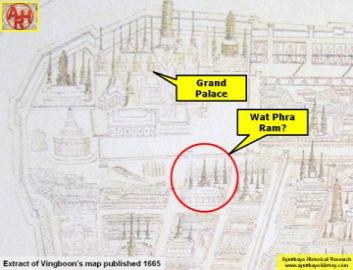
| Excavations Artifacts were found during excavations in the second half of the fifties in the crypt of Wat Phra Ram. Some are at display in the Wat Maha That room of the Chao Sam Phraya Museum. But due to the limited number of findings, the relic chambers of Wat Phra Ram were likely emptied by looters earlier. The Buddha footprint During excavations at Wat Phra Ram, a Buddhapada or an indentation of the footprint of the Buddha was discovered. The object is displayed at the Bangkok National Museum. The sandstone footprint, in Ayutthaya Art, dating back to the 15th century measures 225 cm x 95 cm. Each toe is marked with two spiral shells curling to the right. It is difficult to discern the big toe, as the size of the toes is nearly the same, but I believe it must be the right foot as the marks are clockwise. The sole can be broken up into three parts. The upper part is decorated with large and smaller spiral shells curling to the right; the center part has a wheel adorned by 108 auspicious symbols spread over three concentric circles, while the heel is decorated and features also a number of large and smaller spiral shells curling to the right. The three circles contain the 108 mangalas illustrating the entire world system such as the Mount Meru, the four oceans, the sun and moon, the Himalaya, and the universe itself. The circles surrounding the wheel stand likely for the three realms, the human plane or Manussa Loka (2 circles of 43 symbols), while the inner circle stands for the 6 abodes of the Deva (lower celestial beings) and 16 Brahma (higher celestial being) realms, revealing as thus the Buddhist cosmology. The wheel itself, representing Buddha's teachings and law, consists of a hub and rim with 16 spokes. The depiction of a dharmawheel with 16 spokes is rather rare and could be symbolising the World of Forms (16 Rupa Bhumi). Khun Chang Khun Phaen Wat Phra Ram was before an active monastery and is mentioned in the long poem "Khun Chang Khun Phaen" which was based following Prince Damrong, on a true story from the late fifteenth century. - Elder Khwat followed these orders. He went to stay in Wat Phraram for almost one rains retreat. He did not cast off the character of a Lao person from Lanna, and continued to eat rice and drink liquor in the evenings. He would appear drunk in the ubosot and create trouble until the abbot Phra Phimon could not tolerate it and said, ‘You fake elder, you drunkard, I can’t keep you.’ He was expelled from the chapter of Wat Phraram, and so wandered around with Novice Jiw looking for a wat where they could hide and escape their reputation. - [5] Old photographs From the collection of the aerial photograph Peter Williams-Hunt, who took pictures during reconnaissance missions of Royal Air Force in and after the 2nd World War, I choose two photographs to indicated the state of the ruins of Wat Phra Ram in the year 1946 (photo 1 - photo 2). Another old picture of Wat Phra Ram was found in the book "Ayutthaya - World Heritage Reflections of the Past" from APAO (photo 3) Footnotes: (1) Bueng Phra Ram. (2) An alloy of lead and tin. (3) Moorish. References: [1] The Royal Chronicles of Ayutthaya - Richard D. Cushman (2006) - page 11 / Source: Luang Prasoet. [2] The Royal Chronicles of Ayutthaya - Richard D. Cushman (2006) - page 16 / Source: Phan Canthanumat, British Museum, Reverend Phonnarat, Phra Cakkraphatdiphong & Royal Autograph. [3] Ayutthaya, a world heritage (2000) - page 102/103. [4] The Lord of the Golden Tower - Beth Fouser (1996). [5] Khruangthongsamay Ayutthaya - Krom Silpakorn (2005). [6] A Relation of the Voyage to Siam - Guy Tachard (1688) - page 181/184. [7] Khun Chang Khun Phaen - Chapter 37 - "Soi Fa makes a love charm". Other consulted works: 1. Ayutthaya - World Heritage Reflections of the Past - APAO. 2. Discovering Ayutthaya - Charnvit Kasetsiri & Michael Wright (2007). |
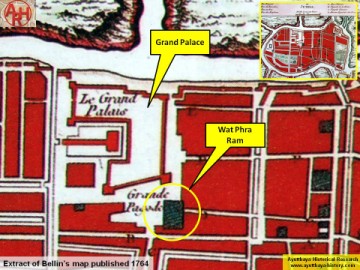
| Text & photographs by Tricky Vandenberg - August 2010 Updated July 2020 |
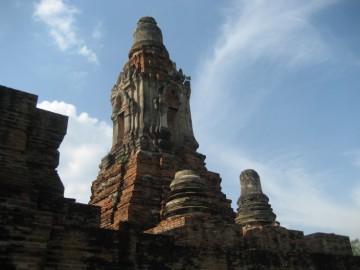


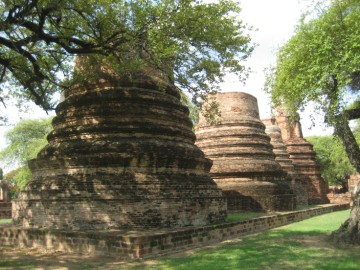
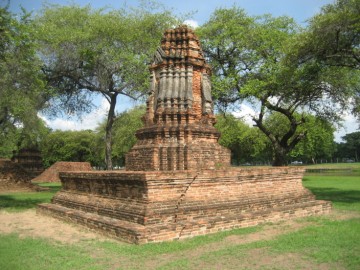

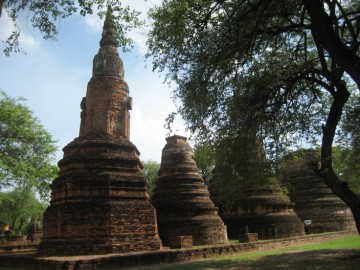
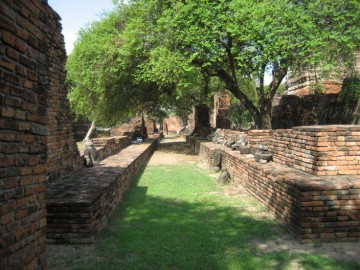
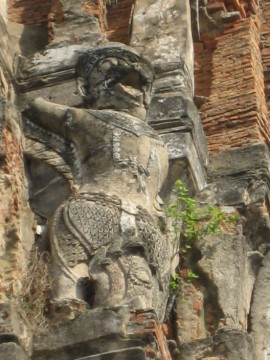

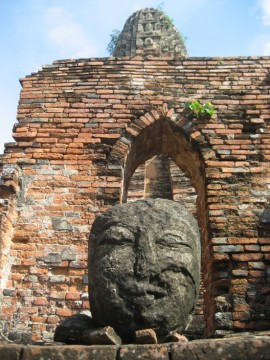
| (View of Wat Phra Ram from the southwest) |
| (Within the complex) |
| (View of the vihara and prang) |
| (Satellite stupa) |

| (View of the vihara and prang) |
| (The former gallery of Wat Phra Ram) |
| (The prang tower of Wat Phra Ram) |
| (Detail of the prang of Wat Phra Ram) |
| (Row of satellite chedi in situ) |
| (Twenty-rabbeted-angled chedi in a square plan) |
| (Row of satellite chedi in situ) |
| (Remnants of a Buddha image at Wat Phra Ram) |
| (Crowned Buddha sheltered by a Naga (Lopburi Art) found at Wat Phra Ram - Chandra Kasem National Museum) |
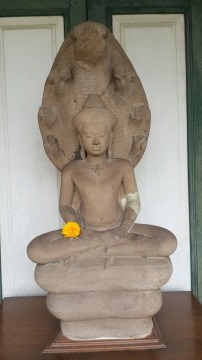
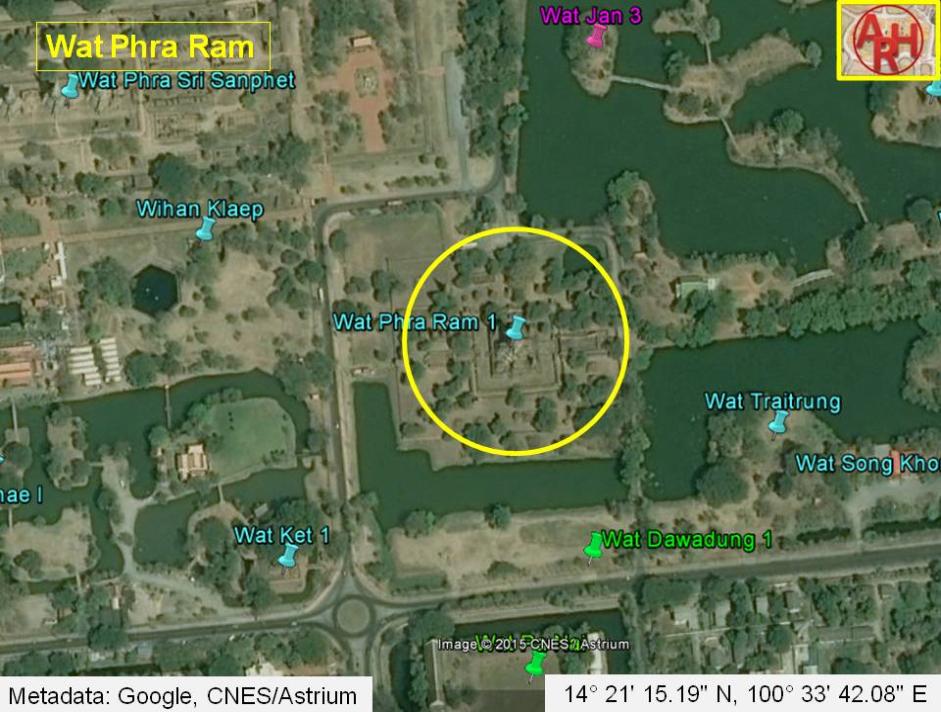
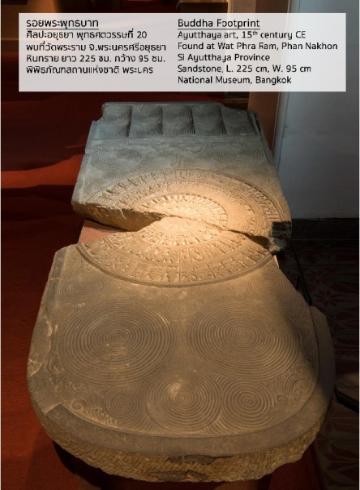
| (Buddha footprint excavated at Wat Phra Ram and displayed at Bangkok National Museum) |